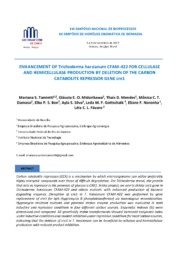Enhancement of Trichoderma harzianum CFAM-422 for cellulase and hemicellulase production by deletion of the carbon catabolite repressor gene cre1.
Enhancement of Trichoderma harzianum CFAM-422 for cellulase and hemicellulase production by deletion of the carbon catabolite repressor gene cre1.
Author(s): TAMIETTI, M. S.; MIDORIKAWA, G. E. O.; MENDES, T. D.; DAMASO, M. C. T.; BOM, E. P. S.; SILVA, A. S.; GOTTSCHALK, L. M. F.; NORONHA, E. F.; FAVARO, L. C. de L.
Summary: Carbon catabolite repression (CCR) is a mechanism by which microorganisms can utilize preferably highly energetic compounds over those of difficult degradation. For Trichoderma reesei, the protein that acts as repressor in the presence of glucose is CRE1. In this project, we aim to delete cre1 gene in Trichoderma harzianum CFAM-422 and obtain mutants with enhanced production of biomass degrading enzymes. Disruption of cre1 in T. harzianum CFAM-422 was performed by gene replacement of cre1 for hph (hygromycin B phosphotransferase) via homologous recombination. Hygromycin resistant mutants and parental strains enzyme production was evaluated in both inductive and repressive conditions in four different carbon sources. Enzymatic indexes (EI) were determined and compared. All genetically stable transformants showed increased enzymatic index under inductive conditions and modest inhibition under repressive conditions for most carbon sources, indicating that the deletion of cre1 in T. harzianum can be beneficial to cellulase and hemicellulase production with reduced product inhibition.
Publication year: 2017
Types of publication: Paper in annals and proceedings
Unit: Embrapa Food Technology
Observation
Some of Embrapa's publications are published as ePub files. To read them, use or download one of the following free software options to your computer or mobile device. Android: Google Play Books; IOS: iBooks; Windows and Linux: Calibre.
Access other publications
Access the Agricultural Research Database (BDPA) to consult Embrapa's full library collection and records.
Visit Embrapa Bookstore to purchase books and other publications sold by Embrapa.

